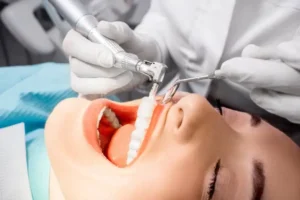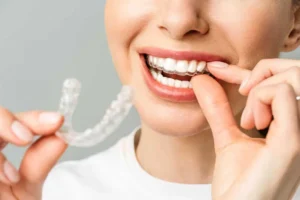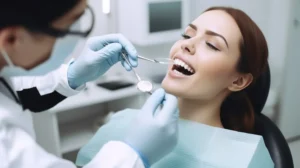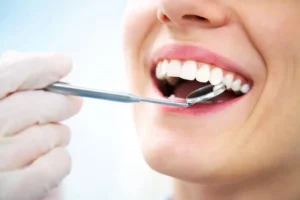Tooth extractions are standard dental procedures, often ideal for treating issues such as severe decay, infection, or crowding. While generally safe, like any surgical procedure, tooth extractions come with potential risks.
Knowing these risks can help you make informed decisions about your dental care. Here are the primary risks associated with tooth extractions and what you can do to mitigate them. For those considering a tooth extraction, our Dentist Glendale AZ ensures a safe and comfortable experience while helping you minimize any potential risks associated with the procedure.
- Infection
One of the most common risks associated with tooth extractions is infection. After a tooth is removed, the socket where the tooth was once left open can be susceptible to bacteria. Signs of infection include swelling, fever, and persistent pain. To minimize this risk, your dentist usually prescribes antibiotics and provides specific aftercare instructions.
- Dry Socket
A dry socket happens when the blood clot that forms in the socket after extraction becomes dislodged before the wound has healed. This can run through the underlying bone and nerves, leading to significant pain and delayed healing.
To prevent dry sockets, avoid smoking, drinking through straws, and vigorous rinsing or spitting for at least 24 hours after the extraction. Contact your dentist quickly if you experience severe pain a few days after your extraction.
- Bleeding
Bleeding is a normal part of the tooth extraction process, but excessive or prolonged bleeding can be a concern. Typically, bleeding should decrease within a few hours after the procedure.
Your dentist will ask you to chew down on a gauze pad for 30-45 minutes to control bleeding. If bleeding persists or is heavy, apply a cold compress and contact your dentist for further instructions.
- Nerve Damage
In rare cases, tooth extractions can lead to nerve damage, mainly when removing wisdom teeth or other molars. This can result in numbness, tingling, or pain in the tongue, lips, or chin. While most nerve damage is temporary and will heal over time, some cases may be permanent. Discuss any matters with your dentist prior to the procedure, especially if the extraction is complex.
- Sinus Complications
For upper molar extractions, there is a small risk of sinus complications. The roots of these teeth are close to the sinuses, and removing them can sometimes create an opening between the mouth and the sinus cavity. Symptoms include a stuffy or runny nose and, in rare cases, a sinus infection. If you experience these symptoms, your dentist may recommend a sinus lift procedure to close the opening and prevent further issues.
- Swelling and Bruising
Swelling and bruising are common side effects of tooth extractions. They typically peak within 48 hours after the procedure and can last for several days. Applying a cold pack to the affected area can help reduce swelling and discomfort. Your dentist may also suggest a pain medication to manage any post-extraction pain.
- Damage to Surrounding Teeth
During the extraction process, adjacent teeth are likely damaged significantly if they are already compromised by decay or previous dental work. Your dentist will take care to minimize this risk, but it’s essential to be aware that it can happen. If you notice any issues with neighbouring teeth after an extraction, inform your dentist immediately.
- Anesthesia Complications
Tooth extractions typically require local anaesthesia and, in some cases, sedation. Although rare, there is a risk of adverse reactions to anaesthesia, like allergic reactions or breathing difficulties. Make sure to discuss your medical history and any known allergies with your dentist before the procedure to help prevent complications.
- Bone Loss
After a tooth extraction, the jawbone that previously supported the tooth can begin to deteriorate and lose density. This process, known as resorption, occurs because the bone no longer receives stimulation from chewing.
Over time, bone loss can affect the alignment of your remaining teeth and the overall function of your face. To prevent significant bone loss, your dentist may recommend a bone graft, which involves placing a small amount of bone material in the socket to encourage new bone growth.
- Prolonged Healing Time
While most tooth extraction sites heal within a few weeks, some factors can prolong the healing process. These factors include smoking, poor oral hygiene, and certain medical conditions such as diabetes. Prolonged healing time increases the risk of infection and other complications. To ensure a smooth recovery, diligently follow your dentist’s aftercare instructions, maintain good oral hygiene, and attend all follow-up appointments.
- Temporomandibular Joint (TMJ) Issues
Tooth extractions, particularly of wisdom teeth, can sometimes cause or exacerbate temporomandibular joint (TMJ) disorders. TMJ issues can lead to pain and discomfort in the jaw, difficulty opening and closing the mouth, and headaches.
If you experience any TMJ symptoms after a tooth extraction, inform your dentist. They can suggest treatments such as physical therapy, jaw exercises, or a night guard to alleviate the symptoms.
- Allergic Reactions
While rare, some patients may feel allergic reactions to the materials used during the extraction procedure, such as latex gloves, local anaesthetics, or medications prescribed for pain management.
Symptoms of an allergic reaction can include itching, swelling, rash, or difficulty breathing. It’s essential to inform your dentist of any known allergies before the procedure. In the event of an allergic reaction, seek immediate medical attention.
- Difficulty Eating
After a tooth extraction, you may experience difficulty eating certain foods, especially those that are hard, crunchy, or sticky. This can be inconvenient and may impact your nutritional intake if the difficulty persists for an extended period.
To manage this, your dentist will likely recommend a soft-food diet for the initial healing period. Foods like yoghurt, mashed potatoes, smoothies, and soups are gentle on the extraction site and can help ensure you receive adequate nutrition while you heal.
- Speech Changes
In some cases, especially when multiple teeth are extracted, you might notice temporary changes in your speech. This can include slurring or difficulty pronouncing certain words. As your mouth heals and adjusts to the changes, these speech issues typically resolve on their own. If they persist, your dentist may suggest speech therapy or dental appliances to assist in correcting the problem.
- Emotional Impact
While often overlooked, the emotional impact of tooth extraction should be considered. Losing a tooth can affect your self-esteem and confidence, mainly if the extracted tooth is visible when you smile. The physical discomfort and dietary restrictions can compound these emotional tolls during the healing period.
Discussing tooth replacement options, such as dental implants, bridges, or dentures, with your dentist can help restore your smile and boost your confidence.
Book a Treatment
While tooth extractions are generally safe and routine procedures, they are not without risks. Being aware of potential complications can help you take the necessary precautions and seek timely help. Always follow your dentist’s aftercare instructions closely to promote healing and lessen the risk of complications.
If you’re considering a tooth extraction, consult with us at Stratland Dental to discuss your concerns and ensure you receive the best care possible. Our experienced team is here to support you through every step of the process.





